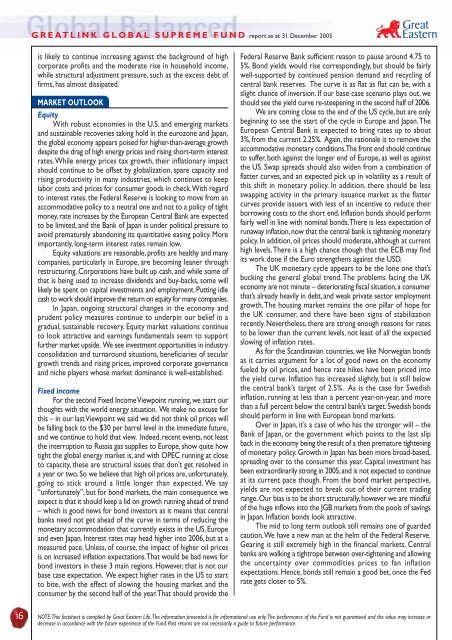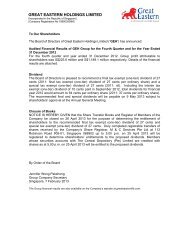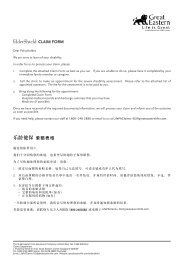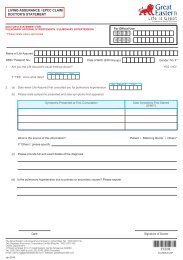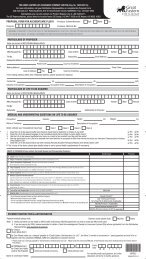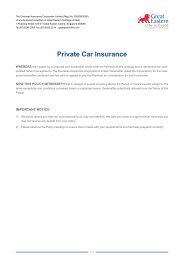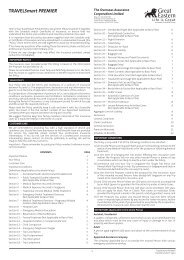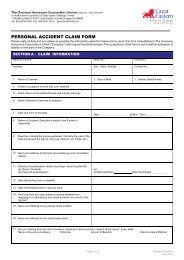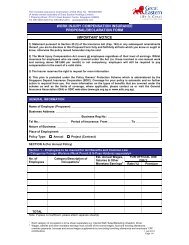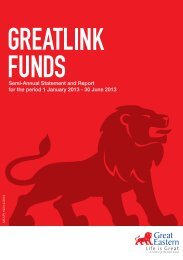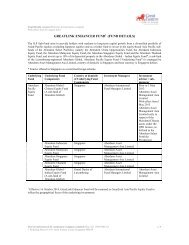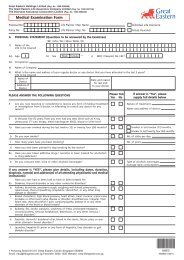Funds GreatLink - Great Eastern Life
Funds GreatLink - Great Eastern Life
Funds GreatLink - Great Eastern Life
Create successful ePaper yourself
Turn your PDF publications into a flip-book with our unique Google optimized e-Paper software.
GREATLINK GLOBAL SUPREME FUND report as at 31 December 2005<br />
is likely to continue increasing against the background of high<br />
corporate profits and the moderate rise in household income,<br />
while structural adjustment pressure, such as the excess debt of<br />
firms, has almost dissipated.<br />
MARKET OUTLOOK<br />
Equity<br />
With robust economies in the U.S. and emerging markets<br />
and sustainable recoveries taking hold in the eurozone and Japan,<br />
the global economy appears poised for higher-than-average growth<br />
despite the drag of high energy prices and rising short-term interest<br />
rates. While energy prices tax growth, their inflationary impact<br />
should continue to be offset by globalization, spare capacity and<br />
rising productivity in many industries, which continues to keep<br />
labor costs and prices for consumer goods in check. With regard<br />
to interest rates, the Federal Reserve is looking to move from an<br />
accommodative policy to a neutral one and not to a policy of tight<br />
money, rate increases by the European Central Bank are expected<br />
to be limited, and the Bank of Japan is under political pressure to<br />
avoid prematurely abandoning its quantitative easing policy. More<br />
importantly, long-term interest rates remain low.<br />
Equity valuations are reasonable, profits are healthy and many<br />
companies, particularly in Europe, are becoming leaner through<br />
restructuring. Corporations have built up cash, and while some of<br />
that is being used to increase dividends and buy-backs, some will<br />
likely be spent on capital investments and employment. Putting idle<br />
cash to work should improve the return on equity for many companies.<br />
In Japan, ongoing structural changes in the economy and<br />
prudent policy measures continue to underpin our belief in a<br />
gradual, sustainable recovery. Equity market valuations continue<br />
to look attractive and earnings fundamentals seem to support<br />
further market upside. We see investment opportunities in industry<br />
consolidation and turnaround situations, beneficiaries of secular<br />
growth trends and rising prices, improved corporate governance<br />
and niche players whose market dominance is well-established.<br />
Fixed income<br />
For the second Fixed Income Viewpoint running, we start our<br />
thoughts with the world energy situation. We make no excuse for<br />
this – in our last Viewpoint we said we did not think oil prices will<br />
be falling back to the $30 per barrel level in the immediate future,<br />
and we continue to hold that view. Indeed, recent events, not least<br />
the interruption to Russia gas supplies to Europe, show quite how<br />
tight the global energy market is, and with OPEC running at close<br />
to capacity, these are structural issues that don’t get resolved in<br />
a year or two. So we believe that high oil prices are, unfortunately,<br />
going to stick around a little longer than expected. We say<br />
“unfortunately”, but for bond markets, the main consequence we<br />
expect is that it should keep a lid on growth running ahead of trend<br />
– which is good news for bond investors as it means that central<br />
banks need not get ahead of the curve in terms of reducing the<br />
monetary accommodation that currently exists in the US, Europe<br />
and even Japan. Interest rates may head higher into 2006, but at a<br />
measured pace. Unless, of course, the impact of higher oil prices<br />
is on increased inflation expectations. That would be bad news for<br />
bond investors in these 3 main regions. However, that is not our<br />
base case expectation. We expect higher rates in the US to start<br />
to bite, with the effect of slowing the housing market and the<br />
consumer by the second half of the year. That should provide the<br />
Federal Reserve Bank sufficient reason to pause around 4.75 to<br />
5%. Bond yields would rise correspondingly, but should be fairly<br />
well-supported by continued pension demand and recycling of<br />
central bank reserves. The curve is as flat as flat can be, with a<br />
slight chance of inversion. If our base case scenario plays out, we<br />
should see the yield curve re-steepening in the second half of 2006.<br />
We are coming close to the end of the US cycle, but are only<br />
beginning to see the start of the cycle in Europe and Japan. The<br />
European Central Bank is expected to bring rates up to about<br />
3%, from the current 2.25%. Again, the rationale is to remove the<br />
accommodative monetary conditions. The front end should continue<br />
to suffer, both against the longer end of Europe, as well as against<br />
the US. Swap spreads should also widen from a combination of<br />
flatter curves, and an expected pick up in volatility as a result of<br />
this shift in monetary policy. In addition, there should be less<br />
swapping activity in the primary issuance market as the flatter<br />
curves provide issuers with less of an incentive to reduce their<br />
borrowing costs to the short end. Inflation bonds should perform<br />
fairly well in line with nominal bonds. There is less expectation of<br />
runaway inflation, now that the central bank is tightening monetary<br />
policy. In addition, oil prices should moderate, although at current<br />
high levels. There is a high chance though that the ECB may find<br />
its work done if the Euro strengthens against the USD.<br />
The UK monetary cycle appears to be the lone one that’s<br />
bucking the general global trend. The problems facing the UK<br />
economy are not minute – deteriorating fiscal situation, a consumer<br />
that’s already heavily in debt, and weak private sector employment<br />
growth. The housing market remains the one pillar of hope for<br />
the UK consumer, and there have been signs of stabilization<br />
recently. Nevertheless, there are strong enough reasons for rates<br />
to be lower than the current levels, not least of all the expected<br />
slowing of inflation rates.<br />
As for the Scandinavian countries, we like Norwegian bonds<br />
as it carries argument for a lot of good news on the economy<br />
fueled by oil prices, and hence rate hikes have been priced into<br />
the yield curve. Inflation has increased slightly, but is still below<br />
the central bank’s target of 2.5%. As is the case for Swedish<br />
inflation, running at less than a percent year-on-year, and more<br />
than a full percent below the central bank’s target. Swedish bonds<br />
should perform in line with European bond markets.<br />
Over in Japan, it’s a case of who has the stronger will – the<br />
Bank of Japan, or the government which points to the last slip<br />
back in the economy being the result of a then premature tightening<br />
of monetary policy. Growth in Japan has been more broad-based,<br />
spreading over to the consumer this year. Capital investment has<br />
been extraordinarily strong in 2005, and is not expected to continue<br />
at its current pace though. From the bond market perspective,<br />
yields are not expected to break out of their current trading<br />
range. Our bias is to be short structurally, however we are mindful<br />
of the huge inflows into the JGB markets from the pools of savings<br />
in Japan. Inflation bonds look attractive.<br />
The mid to long term outlook still remains one of guarded<br />
caution. We have a new man at the helm of the Federal Reserve.<br />
Gearing is still extremely high in the financial markets. Central<br />
banks are walking a tightrope between over-tightening and allowing<br />
the uncertainty over commodities prices to fan inflation<br />
expectations. Hence, bonds still remain a good bet, once the Fed<br />
rate gets closer to 5%.<br />
16 NOTE: This factsheet is compiled by <strong>Great</strong> <strong>Eastern</strong> <strong>Life</strong>. The information presented is for informational use only. The performance of the Fund is not guaranteed and the value may increase or<br />
decrease in accordance with the future experience of the Fund. Past returns are not necessarily a guide to future performance.


